Bud
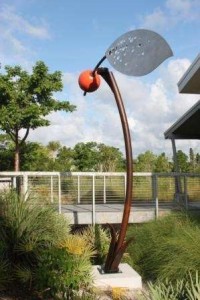 Bud is a 14’ high by 10’ wide by 10’ deep single-axis aluminum and steel kinetic sculpture created by Atlanta metal sculptor Phil Proctor that is located next to the Kapnick Research & Education Center to the right of the entrance of the Naples Botanical Garden. It was purchased by Florida Gulf Coast University in 2011 with funds provided by Florida’s Art in State Buildings Program (Fla. Stat. 255.043).
Bud is a 14’ high by 10’ wide by 10’ deep single-axis aluminum and steel kinetic sculpture created by Atlanta metal sculptor Phil Proctor that is located next to the Kapnick Research & Education Center to the right of the entrance of the Naples Botanical Garden. It was purchased by Florida Gulf Coast University in 2011 with funds provided by Florida’s Art in State Buildings Program (Fla. Stat. 255.043).
The top of Bud rotates in the wind. By including one or more moving components, kinetic sculptures like Bud define the relationship between matter and energy. They express a relationship between objects and forces in our physical environment. Built from materials of structural purpose but with organic form, shape and motion, Bud 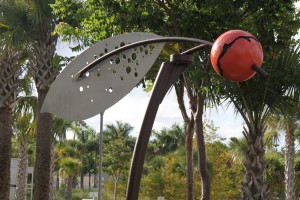 illustrates man’s desire to organize and define the chaos of the natural world, thus making it a good and logical fit for its inclusion in the Naples Botanical Garden.
illustrates man’s desire to organize and define the chaos of the natural world, thus making it a good and logical fit for its inclusion in the Naples Botanical Garden.
Proctor works with found and recycled objects. He prefers “solid” materials like metal and stone, using them in a manner that accommodates their 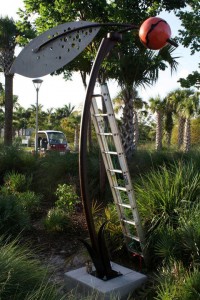 natural tendencies. His approach is interpretive. Proctor explores their materiality to find their “voice.” In essence, the materials tell him what they are, what they were or what they desire to be. This intuitive approach gives Proctor a way to analyze his own interactions with culture, life and physical existence.
natural tendencies. His approach is interpretive. Proctor explores their materiality to find their “voice.” In essence, the materials tell him what they are, what they were or what they desire to be. This intuitive approach gives Proctor a way to analyze his own interactions with culture, life and physical existence.
Proctor also utilizes the colors and textures that occur as a result of natural oxidation and patination. This technique makes his outdoor sculpture virtually maintenance free while simultaneously exhibiting qualities of earthliness and wholeness.
Bud was fabricated in 2009 and first exhibited as part of the Atlanta Beltline Art Project between May and October of 2010 before being acquired by FGCU for installation in the Naples Botanical Garden.
About Phil Proctor
 Metal sculptor Phil Proctor has been living and working in southeast Atlanta since 2003. Originally from south Mississippi, he holds a BFA from the University of Southern Mississippi and an MFA from East Carolina University. Proctor has permanent sculpture installations throughout the southeast, as well as a number of countries across Western Europe.
Metal sculptor Phil Proctor has been living and working in southeast Atlanta since 2003. Originally from south Mississippi, he holds a BFA from the University of Southern Mississippi and an MFA from East Carolina University. Proctor has permanent sculpture installations throughout the southeast, as well as a number of countries across Western Europe.
In 2003 Phil was commissioned by a private development group in conjunction with the City of Atlanta and Marta to design and construct a public artwork, Linkage, which stands at Atlanta’s second busiest Marta station handling an average of 23,400 boardings per weekday. This 75 foot linear sculpture incorporates aluminum and copper plates that represent the expansive reach of MARTA and the way it links communities together through the ease of transportation.
Located at South Bend Park, Anchored Sail is one of six projects commissioned by the city as part of the Public Art Community Gateway Project. This 22 foot tall kinetic artwork incorporates elements that symbolically reflect the historical and cultural values of the
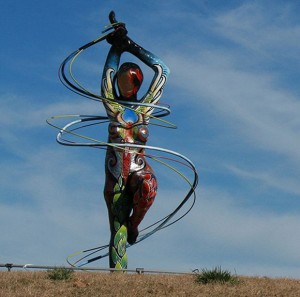 Proctor’s best known sculpture is One Woman Rising, a 12-foot tall female figure representing a woman rising in dance. He created this piece at the request of Atlanta’s Chelko Foundation for One Billion Rising, a global movement that demands an end to violence against women and girls. The sculpture stands in Freedom Park, atop the hill east of the intersection of Moreland Avenue and Freedom Parkway in Atlanta, GA.
Proctor’s best known sculpture is One Woman Rising, a 12-foot tall female figure representing a woman rising in dance. He created this piece at the request of Atlanta’s Chelko Foundation for One Billion Rising, a global movement that demands an end to violence against women and girls. The sculpture stands in Freedom Park, atop the hill east of the intersection of Moreland Avenue and Freedom Parkway in Atlanta, GA.
“In keeping with Paul Chelko’s vision to end gender bias and empower women worldwide, this 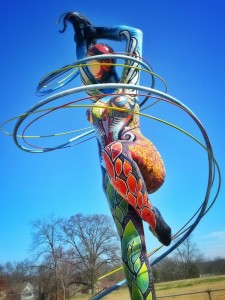 highly visible landmark is inspired by Eve Ensler’s recent global day of action, One Billion Rising, calling for the end of violence against women and girls,” says the Foundation of the sculpture. “Fabricated by Atlanta artisan Phil Proctor , assisted by Geo Brenick (Geo4Design), the abstract sculpted dancing woman speaks to the celebration of woman’s release from bondage and her dynamic move into a new creative space.” The statue radiates the grace of the feminine form and is painted by World Champion body painters, Scott Fray and Madelyn Greco (Living Brush Bodypainting). Surrounding the sculpture is a railing where viewers are invited to use ribbons and markers to share their reasons for rising and their stories of empowerment and survival.
highly visible landmark is inspired by Eve Ensler’s recent global day of action, One Billion Rising, calling for the end of violence against women and girls,” says the Foundation of the sculpture. “Fabricated by Atlanta artisan Phil Proctor , assisted by Geo Brenick (Geo4Design), the abstract sculpted dancing woman speaks to the celebration of woman’s release from bondage and her dynamic move into a new creative space.” The statue radiates the grace of the feminine form and is painted by World Champion body painters, Scott Fray and Madelyn Greco (Living Brush Bodypainting). Surrounding the sculpture is a railing where viewers are invited to use ribbons and markers to share their reasons for rising and their stories of empowerment and survival.
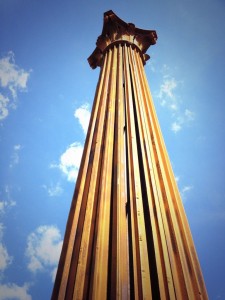 Proctor’s most recent project is a 23-foot tall Corinthian column weighing over 13 tons for the Atlanta Beltline Art Project. The Atlanta BeltLine is a sustainable redevelopment project that will provide a network of public parks, multi-use trails and transit along a historic 22-mile railroad corridor circling downtown and connecting many neighborhoods directly to each other.
Proctor’s most recent project is a 23-foot tall Corinthian column weighing over 13 tons for the Atlanta Beltline Art Project. The Atlanta BeltLine is a sustainable redevelopment project that will provide a network of public parks, multi-use trails and transit along a historic 22-mile railroad corridor circling downtown and connecting many neighborhoods directly to each other.
Created out of railroad artifacts, Iron Column symbolizes Atlanta’s architectural and railroad history while recalling the Corinthian columns that adorned the façade of the former Union Station, the city’s main railroad station, which was demolished in 1972. Using rails, spikes, plates, switches, and rail anchors, Proctor’s design was chosen from more than 20 competitive applications. The selection panel included representatives of Atlanta BeltLine, Inc., City of Atlanta Office of Cultural Affairs, the Georgia Chapter of the International Interior Design Association (IIDA), and members from the arts community.
“This piece marks a new milestone for public art on the Atlanta BeltLine,” said Paul Morris, President and CEO of Atlanta BeltLine, Inc. “Using the history of this rail corridor to enhance the new public realm is another step towards the fulfillment of the comprehensive Atlanta BeltLine vision.” Adds IIDA chapter president Ronnie Belizaire, “Public art has a significant impact on quality of life and adds value to communities and is integral to new public realms like the Atlanta BeltLine.”
“I have always been intrigued by classical architecture,” said artist Phil Proctor. “As I was researching Atlanta’s history, I noticed how the classical styles implemented in old rail stations have since been lost to war, neglect, or to make way for new steel and glass buildings. The goal of this sculpture is to celebrate the history of Atlanta and recognize the significant role of the railroad.” The railroad once existed as a border between neighborhoods, a birthplace of industry and the foundation of Atlanta as a trade and business hub. However, in the past decades the corridor has been subject to years of neglect, with businesses and residences facing away from the rail corridor. As the Atlanta BeltLine develops, the historic rail is being removed, giving way to a multi-use trail and transit corridor, readopting the corridor as a public amenity. This monumental sculpture represents the history of the Atlanta BeltLine as a rail corridor, preserving historic artifacts and contributing to the beautification of the corridor through public art.
The installation was completed in time for the launch of the 2013 Art on the Atlanta BeltLine exhibition that began September 7, 2013. Art on the Atlanta BeltLine was the largest temporary public art project in Atlanta to date, with over 70 innovative works of performance and visual art. The exhibition positioned emerging art alongside established art, with featured installations by new and returning artists. Eight miles of paved and interim hiking trails around the 22-mile Atlanta BeltLine corridor provided the public space for the two-month long exhibition. Though the pieces showcased in this exhibition were temporary, they were complemented by Art on the Atlanta BeltLine’s year-round collection that now includes the Corinthian Column. It is located on the Eastside Trail at the north end of the Historic Fourth Ward Skatepark.
In addition to commissioned works, Proctor frequently exhibits his large scale sculpture locally and regionally in such venues as Hartsfield-Jackson International Airport. His artwork has had a positive impact on communities, which has led to purchases from patrons such as the City of Sandy Springs for “Sky Lark” which currently stands at the Sandy Springs public library.
About the Naples Botanical Gardens
Naples Botanical Garden is a 170-acre world-class garden paradise that features the plants and cultures of the tropics and subtropics between the latitudes of 26 degrees North and 26 degrees South including Brazil, the Caribbean, Southeast Asia and Florida. A hands-on interactive Children’s Garden along with 90 acres of beautifully restored natural habitats, walking trails and a Butterfly Garden offer educational entertainment and enjoyment for people of all ages. Founded in 1993, the Garden re-opened to the public in November 2009 after an extensive expansion.
Naples Botanical Garden is located at 4820 Bayshore Drive, Naples, Florida 34112. For more information, please visit http://www.naplesgarden.org, email info@naplesgarden.org or telephone 239-643-7275.
Naples Botanical Garden is rated 4 Stars by Charity Navigator














 Tom Hall is both an amateur artist and aspiring novelist who writes art quest thrillers. He is in the final stages of completing his debut novel titled "Art Detective," a story that fictionalizes the discovery of the fabled billion-dollar Impressionist collection of Parisian art dealer Josse Bernheim-Jeune, thought by many to have perished during World War II when the collection's hiding place, Castle de Rastignac in southern France, was destroyed by the Wehrmacht in reprisal for attacks made by members of the Resistance operating in the area. A former tax attorney, Tom holds a bachelor's degree as well as both a juris doctorate and masters of laws in taxation from the University of Florida. Tom lives in Estero, Florida with his fiancee, Connie, and their four cats.
Tom Hall is both an amateur artist and aspiring novelist who writes art quest thrillers. He is in the final stages of completing his debut novel titled "Art Detective," a story that fictionalizes the discovery of the fabled billion-dollar Impressionist collection of Parisian art dealer Josse Bernheim-Jeune, thought by many to have perished during World War II when the collection's hiding place, Castle de Rastignac in southern France, was destroyed by the Wehrmacht in reprisal for attacks made by members of the Resistance operating in the area. A former tax attorney, Tom holds a bachelor's degree as well as both a juris doctorate and masters of laws in taxation from the University of Florida. Tom lives in Estero, Florida with his fiancee, Connie, and their four cats.